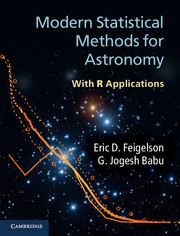Book contents
- Frontmatter
- Contents
- Preface
- 1 Introduction
- 2 Probability
- 3 Statistical inference
- 4 Probability distribution functions
- 5 Nonparametric statistics
- 6 Data smoothing: density estimation
- 7 Regression
- 8 Multivariate analysis
- 9 Clustering, classification and data mining
- 10 Nondetections: censored and truncated data
- 11 Time series analysis
- 12 Spatial point processes
- Appendix A Notation and acronyms
- Appendix B Getting started with R
- Appendix C Astronomical datasets
- References
- Subject index
- R and CRAN commands
- Plate section
2 - Probability
Published online by Cambridge University Press: 05 November 2012
- Frontmatter
- Contents
- Preface
- 1 Introduction
- 2 Probability
- 3 Statistical inference
- 4 Probability distribution functions
- 5 Nonparametric statistics
- 6 Data smoothing: density estimation
- 7 Regression
- 8 Multivariate analysis
- 9 Clustering, classification and data mining
- 10 Nondetections: censored and truncated data
- 11 Time series analysis
- 12 Spatial point processes
- Appendix A Notation and acronyms
- Appendix B Getting started with R
- Appendix C Astronomical datasets
- References
- Subject index
- R and CRAN commands
- Plate section
Summary
Uncertainty in observational science
Probability theory models uncertainty. Observational scientists often come across events whose outcome is uncertain. It may be physically impossible, too expensive or even counterproductive to observe all the inputs. The astronomer might want to measure the location and motions of all stars in a globular cluster to understand its dynamical state. But even with the best telescopes, only a fraction of the stars can be located in the two dimensions of sky coordinates with the third distance dimension unobtainable. Only one component (the radial velocity) of the three-dimensional velocity vector can be measured, and this may be accessible for only a few cluster members. Furthermore, limitations of the spectrograph and observing conditions lead to uncertainty in the measured radial velocities. Thus, our knowledge of the structure and dynamics of globular clusters is subject to considerable restrictions and uncertainty.
In developing the basic principles of uncertainty, we will consider both astronomical systems and simple familiar systems such as a tossed coin. The outcome of a toss, heads or tails, is completely determined by the forces on the coin and Newton's laws ofmotion. Butwe would need to measure too many parameters of the coin's trajectory and rotations to predict with acceptable reliability which face of the coin will be up. The outcomes of coin tosses are thus considered to be uncertain even though they are regulated by deterministic physical processes.
- Type
- Chapter
- Information
- Modern Statistical Methods for AstronomyWith R Applications, pp. 13 - 34Publisher: Cambridge University PressPrint publication year: 2012

